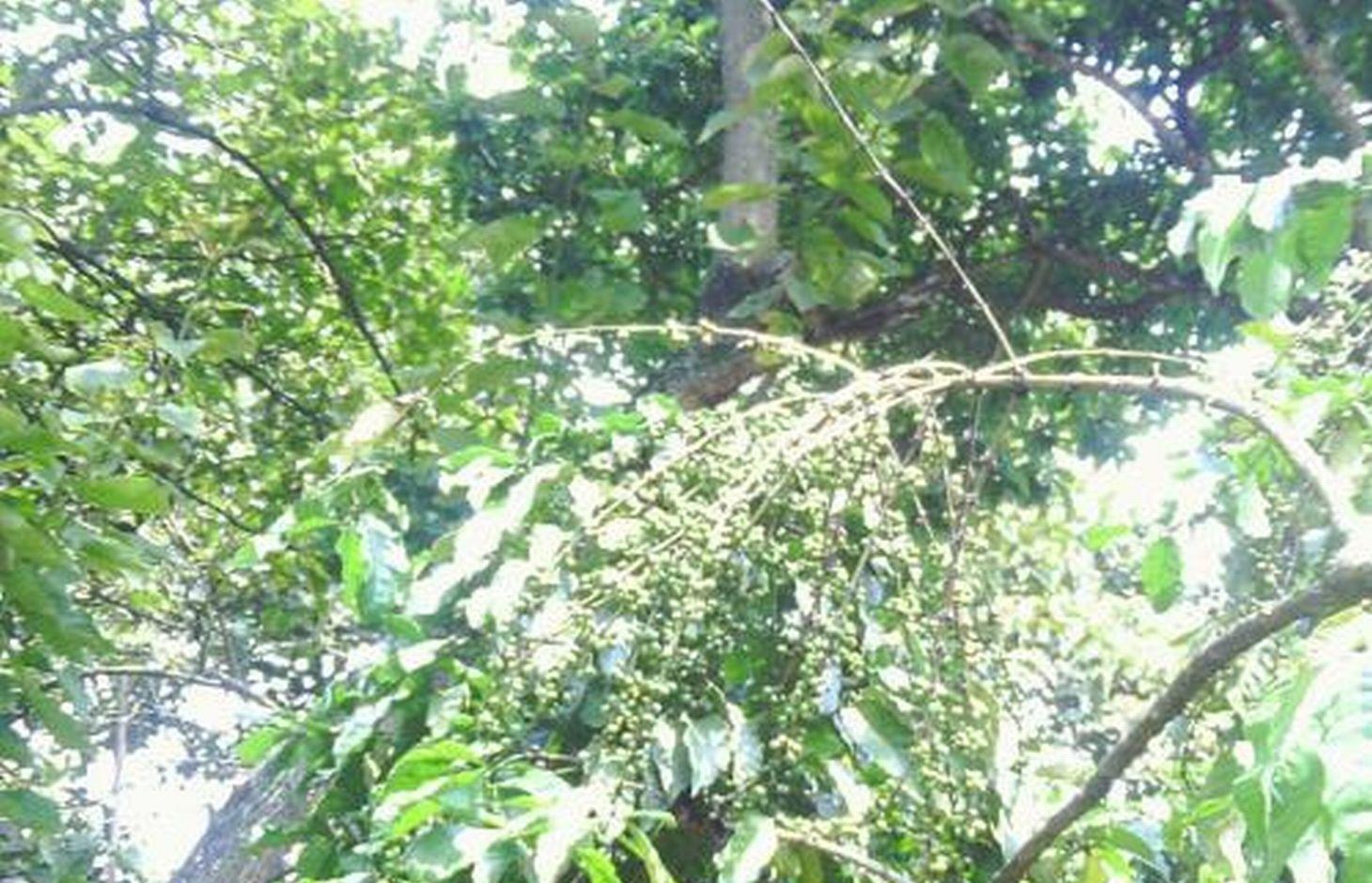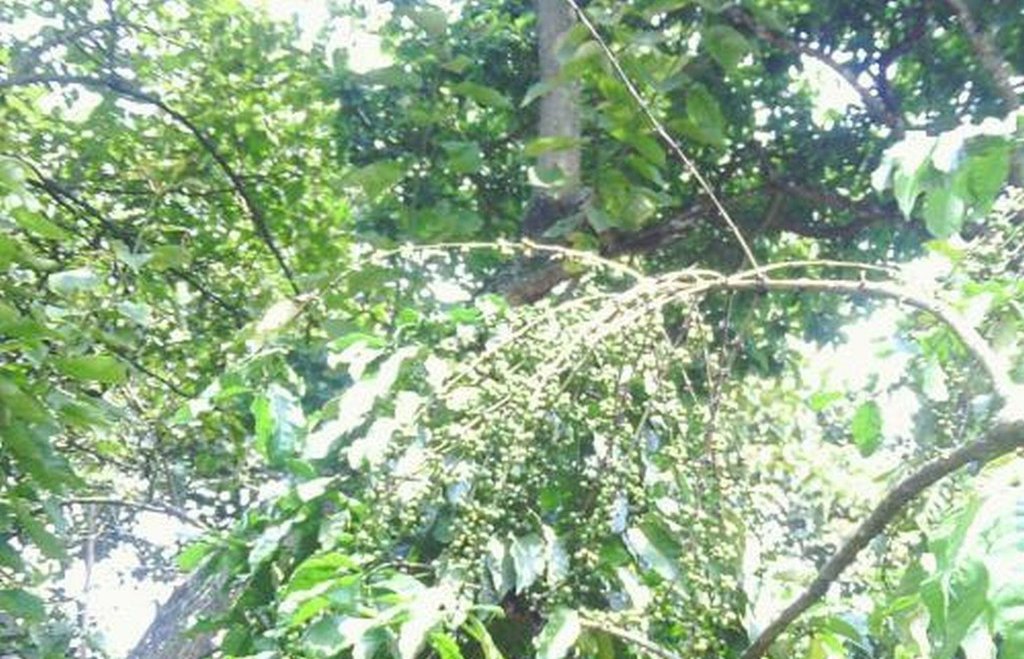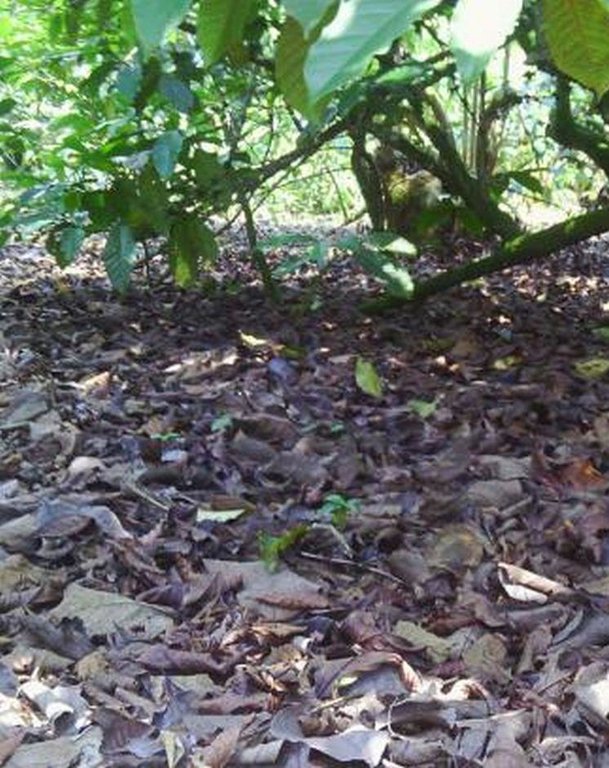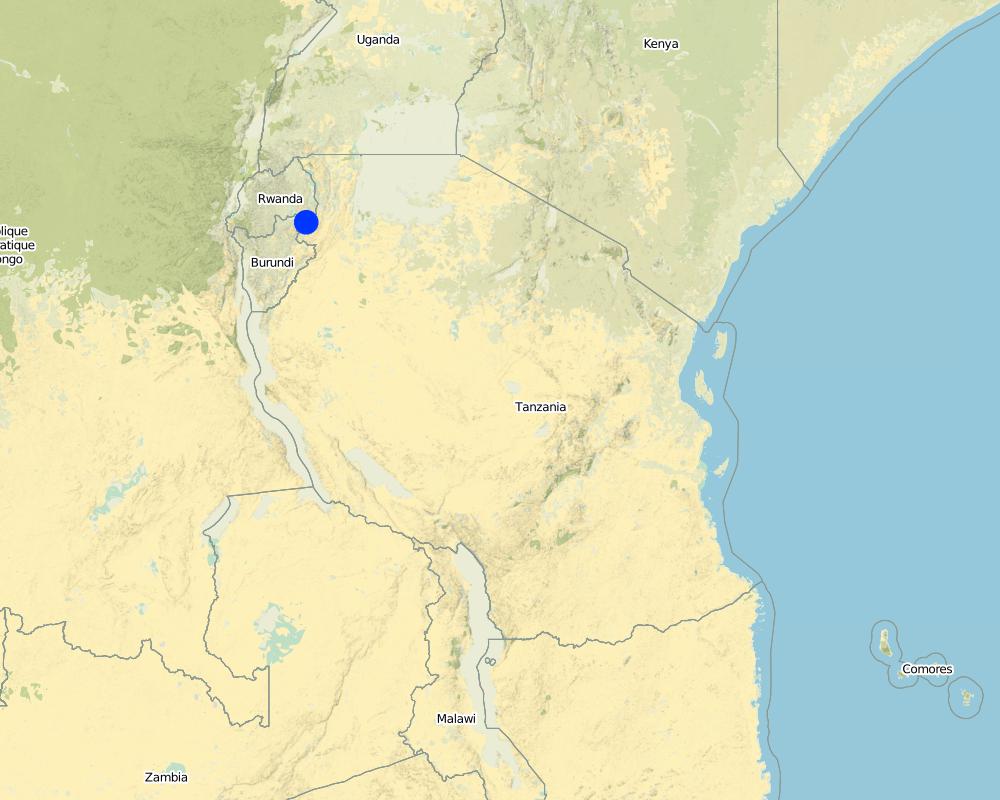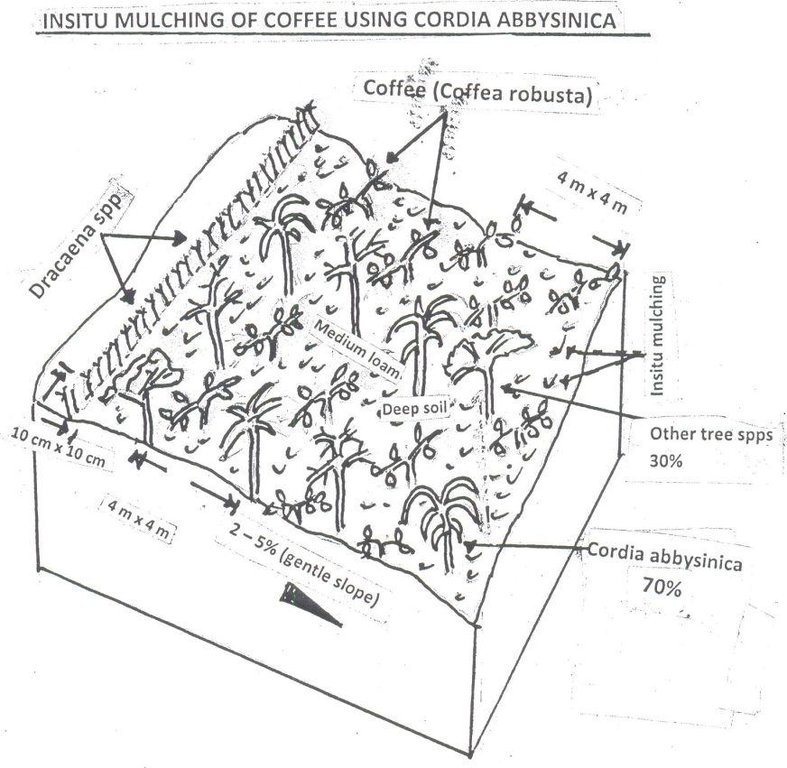In situ mulching of coffee using Cordia Abbysinica [Tanzania, United Republic of]
- Creation:
- Update:
- Compiler: Bertha Munyaga
- Editor: –
- Reviewer: Alexandra Gavilano
Kgutela igitutu ckimwani
technologies_1191 - Tanzania, United Republic of
View sections
Expand all Collapse all1. General information
1.2 Contact details of resource persons and institutions involved in the assessment and documentation of the Technology
SLM specialist:
SLM specialist:
Name of project which facilitated the documentation/ evaluation of the Technology (if relevant)
The Transboundary Agro-ecosystem Management Project for the Kagera River Basin (GEF-FAO / Kagera TAMP )Name of the institution(s) which facilitated the documentation/ evaluation of the Technology (if relevant)
Food and Agriculture Organization of the United Nations (FAO) - ItalyName of the institution(s) which facilitated the documentation/ evaluation of the Technology (if relevant)
Food and Agriculture Organization of the United Nations (FAO) - Italy1.3 Conditions regarding the use of data documented through WOCAT
The compiler and key resource person(s) accept the conditions regarding the use of data documented through WOCAT:
Yes
2. Description of the SLM Technology
2.1 Short description of the Technology
Definition of the Technology:
Use of indigenous trees to provide shade and leaves droppings as mulch for coffee production
2.2 Detailed description of the Technology
Description:
Establishment of Robusta coffee farms by an individual,on a cropland by mixing indigenous tree spp which provide a shade and dropping leaves save as natural mulch.The technology has been developed through land user initiatives over 40 years ago. Establishment activities include land clearing and preparation,preparation of holes,seed collection and planting which involve family labor Seeds are collected from neighboring village from mature trees. Holes are prepared randomly about 4 meters apart. No inputs are applied at the establishment stage only hand tools are used (hand hoe, matchet)
Shade trees are planted after establishment of coffee which are randomly planted, tree spp dominating is Cordia abbysinica which has broader leaves and easy to decompose.Other tree spp included are Erythrina,Meosopsis eminii,Ficus thornngii,Makhamia lutea and Tephrosia vogelii.
Maintenance include weeding which is done by pulling weeds by hand or using hand hoe at early stage after establishment because few leaves have dropped. The farm is mainly meant for coffee production however,few crops which are cassava bananas, fruit trees Jack fruit, Mangoes, Citrus spp which are planted in the peripherals,and Dracaena sppplanted to demarcate the farm along road side.
Pruning of tree branches is done before the shade is heavy as to allow ventilation.Coffee pruning is done to an individual tree depending on number of branches it has at time of harvesting, normally 4 branches are left. Bending of coffee branches is practiced to avoid branch breaking during harvesting.
Settlement is within the farm with few livestock which are sheep, cattle and chicken.
Purpose of the Technology: To increase coffee production by mixing coffee with indigenous tree spp which drop / shed its leaves.Selected trees are those broad leaved which its leaves decompose easily hence improve soil fertility and due to high accumulation of dropped leaves there is an increase in soil moisture content.
Trees act as wind break hence no flower drop.Dracaena spp are planted very close along the road side to demarcate his plot from neighbors and public infrastructure and this helps to reduce land conflicts among neighbors and community as well.
Hand weeding is done as the technology suppress weeds to the big shade.
Establishment / maintenance activities and inputs: A farmer bought a piece of land from the village government.Establishment activities include land clearance by removal of shrubs using a matchet.This is followed by land preparations and planting holes which are 30cm depth and 30cm width. These activities are done from May to July by family labor.Planting is normally done between September and October by collecting seedlings from mature trees in neighbors fields.Planting of indigenous tree spp is done randomly after coffee planting to allow ventilation 80 different spps are planted in 1.5 acres. Seeds and seedlings are obtained from neighbors farms.Maintenance includes weeding which is done using family labor who use hand hoe. This is done twice a year in May and December to January. Pruning and bending of coffee tree branches is done once per year after harvesting of coffee as well as trees in June and July using a matchet. Each coffee tree is treated individually only 4 branches are allowed per tree. Bending is done to avoid breaking of branches during coffee harvesting.
Gap filling is done few months after transplanting between February and March at the beginning of long rains. and this was followed pruning and bending of coffee branches.
Demarcation of coffee farm using Dracaena (shrub) done on one side of his farm along the road.
Natural / human environment: Land use type: Establishment of coffee has been done on crop land.
Agronomic: Natural mulch from leaves falling on ground.
Vegetative: Demarcation of boundary using Dracaena spp.
Climatic zone: Sub humid more than 269 growing days.
slope: 2-5% gentle slope
Soil type: Clay loam
Soil depth: Deep
Tools and inputs: Hand hoes,bush knife,axe, seeds and cuttings.
Land ownership: Individually owned.
2.3 Photos of the Technology
2.5 Country/ region/ locations where the Technology has been applied and which are covered by this assessment
Country:
Tanzania, United Republic of
Region/ State/ Province:
Tanzania
Further specification of location:
Ngara District
Specify the spread of the Technology:
- evenly spread over an area
If precise area is not known, indicate approximate area covered:
- < 0.1 km2 (10 ha)
Comments:
Boundary points of the Technology area: 236229742E 236229740E 236229639E 236229639E
9726279N 9726387N 9726293N 9726392N
Map
×2.6 Date of implementation
If precise year is not known, indicate approximate date:
- 10-50 years ago
2.7 Introduction of the Technology
Specify how the Technology was introduced:
- through projects/ external interventions
Comments (type of project, etc.):
The technology was adopted from Muleba district and adapted in Kirusya village
3. Classification of the SLM Technology
3.2 Current land use type(s) where the Technology is applied

Cropland
- Perennial (non-woody) cropping
- Tree and shrub cropping
Perennial (non-woody) cropping - Specify crops:
- banana/plantain/abaca
Tree and shrub cropping - Specify crops:
- avocado
- citrus
- coffee, open grown
- mango, mangosteen, guava
- Cordia abbysinica, Erythrina,Meosopsis eminii,Ficus thornngii,Makhamia lutea and Tephrosia vogelii, Jack fruit, Mandarines
Number of growing seasons per year:
- 2
Specify:
Longest growing period in days: 120Longest growing period from month to month: September-DecemberSecond longest growing period in days: 90Second longest growing period from month to month: March-May

Grazing land
- Tethering: rapid decline of land due to expansion of settlements and crop production
Animal type:
- sheep
- cattle, chicken
Comments:
Livestock density (if relevant):
10-25 LU /km2
Major land use problems (compiler’s opinion): Soil erosion, water loss/moisture stress, loss of nutrients through leaching and flower drop which lead to reduced yield.
Major land use problems (land users’ perception): Poor soil fertility and water stress
3.4 Water supply
Water supply for the land on which the Technology is applied:
- rainfed
3.6 SLM measures comprising the Technology

agronomic measures
- A1: Vegetation/ soil cover
- A2: Organic matter/ soil fertility
- A3: Soil surface treatment
A3: Differentiate tillage systems:
A 3.2: Reduced tillage (> 30% soil cover)

vegetative measures
- V1: Tree and shrub cover

management measures
- M3: Layout according to natural and human environment
Comments:
Type of agronomic measures: mulching, manure / compost / residues, minimum tillage
Type of vegetative measures: aligned: -along boundary, scattered / dispersed
3.7 Main types of land degradation addressed by the Technology

soil erosion by water
- Wt: loss of topsoil/ surface erosion

chemical soil deterioration
- Cn: fertility decline and reduced organic matter content (not caused by erosion)

biological degradation
- Bc: reduction of vegetation cover
Comments:
Main causes of degradation: crop management (annual, perennial, tree/shrub) (indigenous tree,fruits and coffee. (shrubs)), change in temperature (Loss of water due to evapo transpiration), labour availability (Vegetation degradation)
Secondary causes of degradation: change of seasonal rainfall (Change of seasonal rainfall), wind storms / dust storms (De flowering leading to production loss)
3.8 Prevention, reduction, or restoration of land degradation
Specify the goal of the Technology with regard to land degradation:
- prevent land degradation
- reduce land degradation
4. Technical specifications, implementation activities, inputs, and costs
4.1 Technical drawing of the Technology
Technical specifications (related to technical drawing):
Indigenous tree are randomly planted and Cordia Abbysinica accounts for 70% of the indegenous tree spps. Demarcation of a coffee farm is done using Dracaena (shrub) done on one side of the farm along the road. Natural mulching is done by tree leaves/debris falling on ground. Slope category range from 2-5% gentle slope. Average spacing of Robusta coffee is 4m x 4m.
Location: Karushya Nyamigango. Ngara/Kagera/Tanzania
Technical knowledge required for land users: high
Main technical functions: improvement of ground cover, increase in organic matter, increase in nutrient availability (supply, recycling,…), increase of infiltration, increase / maintain water stored in soil
Secondary technical functions: reduction in wind speed
Mulching
Material/ species: leavesof indigenous trees drop
Quantity/ density: 6 cm depth
Remarks: natural falling and irregular aligment
Manure / compost / residues
Material/ species: indigenous trees
Minimum tillage
Material/ species: Hand pulling sometimes use simple tools.
Aligned: -along boundary
Number of plants per (ha): 1,000
Vertical interval between rows / strips / blocks (m): 0
Spacing between rows / strips / blocks (m): 0.1
Vertical interval within rows / strips / blocks (m): 0
Width within rows / strips / blocks (m): 0
Scattered / dispersed
Number of plants per (ha): 375
Vertical interval between rows / strips / blocks (m): 3
Spacing between rows / strips / blocks (m): 60
Vertical interval within rows / strips / blocks (m): 3
Width within rows / strips / blocks (m): 60
Trees/ shrubs species: Cordia abbysinica, Ficus spp,Erythrina spp,Makhamia spp,Tephrosia spp Maesopsis spp (planted)
Fruit trees / shrubs species: avocado, mandarine,
Perennial crops species: Coffee
Other type of management: (Land protection and demarcation)
Planting Dracaena along the road side
Author:
Allan Bubelwa, P.O.Box 38 Kyaka Missenyi Kagera Tanzania
Date:
10/04/2014
4.2 General information regarding the calculation of inputs and costs
other/ national currency (specify):
Tanzanian shillings
If relevant, indicate exchange rate from USD to local currency (e.g. 1 USD = 79.9 Brazilian Real): 1 USD =:
1600.0
Indicate average wage cost of hired labour per day:
3000.00
4.3 Establishment activities
| Activity | Timing (season) | |
|---|---|---|
| 1. | Hole preparation | Nov. |
| 2. | Seed collection and preparation | Nov to Dec |
| 3. | Seedling planting | Dec |
| 4. | Demarcation and excavation of small trench | September-before long rains |
| 5. | Preparation of cuttings | September-December |
| 6. | Actual planting | September-December |
| 7. | labour | |
| 8. | pangas (matchet) | |
| 9. | handhole | |
| 10. | tree & coffee seedlings |
4.4 Costs and inputs needed for establishment
| Specify input | Unit | Quantity | Costs per Unit | Total costs per input | % of costs borne by land users | |
|---|---|---|---|---|---|---|
| Labour | labour | 1.0 | 2510.4 | 2510.4 | 100.0 | |
| Equipment | tools | 1.0 | 21.88 | 21.88 | 100.0 | |
| Plant material | seeds | 1.0 | 31.25 | 31.25 | 100.0 | |
| Plant material | seedlings | 1.0 | 61.73 | 61.73 | 100.0 | |
| Total costs for establishment of the Technology | 2625.26 | |||||
| Total costs for establishment of the Technology in USD | 1.64 | |||||
Comments:
Duration of establishment phase: 6 month(s)
4.5 Maintenance/ recurrent activities
| Activity | Timing/ frequency | |
|---|---|---|
| 1. | Pruning-Trees-Coffee | After harvesting, June-July |
| 2. | Weeding | after long rain season |
| 3. | Gap filling | March,during short rains |
| 4. | Bending and layering | Once after harvesting |
| 5. | Gap filling | before short rains |
| 6. | Prunning | Dry season |
4.6 Costs and inputs needed for maintenance/ recurrent activities (per year)
| Specify input | Unit | Quantity | Costs per Unit | Total costs per input | % of costs borne by land users | |
|---|---|---|---|---|---|---|
| Labour | labour | 1.0 | 63.63 | 63.63 | 100.0 | |
| Plant material | seedlings | 1.0 | 33.05 | 33.05 | 100.0 | |
| Total costs for maintenance of the Technology | 96.68 | |||||
| Total costs for maintenance of the Technology in USD | 0.06 | |||||
Comments:
Machinery/ tools: Hand hoe, panga (matchet) and axe, Panga (Matchet), hand hoe and axe
The cost assesment was completed on 18 February 2014. The cost of labour can be reduced during the onset of rain when the soil is a bit workable.
4.7 Most important factors affecting the costs
Describe the most determinate factors affecting the costs:
Labour
5. Natural and human environment
5.1 Climate
Annual rainfall
- < 250 mm
- 251-500 mm
- 501-750 mm
- 751-1,000 mm
- 1,001-1,500 mm
- 1,501-2,000 mm
- 2,001-3,000 mm
- 3,001-4,000 mm
- > 4,000 mm
Agro-climatic zone
- sub-humid
Thermal climate class: tropics. All months above 18°C
5.2 Topography
Slopes on average:
- flat (0-2%)
- gentle (3-5%)
- moderate (6-10%)
- rolling (11-15%)
- hilly (16-30%)
- steep (31-60%)
- very steep (>60%)
Landforms:
- plateau/plains
- ridges
- mountain slopes
- hill slopes
- footslopes
- valley floors
Altitudinal zone:
- 0-100 m a.s.l.
- 101-500 m a.s.l.
- 501-1,000 m a.s.l.
- 1,001-1,500 m a.s.l.
- 1,501-2,000 m a.s.l.
- 2,001-2,500 m a.s.l.
- 2,501-3,000 m a.s.l.
- 3,001-4,000 m a.s.l.
- > 4,000 m a.s.l.
5.3 Soils
Soil depth on average:
- very shallow (0-20 cm)
- shallow (21-50 cm)
- moderately deep (51-80 cm)
- deep (81-120 cm)
- very deep (> 120 cm)
Soil texture (topsoil):
- coarse/ light (sandy)
Topsoil organic matter:
- high (>3%)
5.4 Water availability and quality
Ground water table:
> 50 m
Availability of surface water:
good
Water quality (untreated):
good drinking water
5.5 Biodiversity
Species diversity:
- medium
5.6 Characteristics of land users applying the Technology
Market orientation of production system:
- commercial/ market
Off-farm income:
- less than 10% of all income
Relative level of wealth:
- average
Individuals or groups:
- individual/ household
Level of mechanization:
- manual work
Gender:
- men
Indicate other relevant characteristics of the land users:
Difference in the involvement of women and men: Tree and coffee pruning is done by men because it needs climbing
Population density: 10-50 persons/km2
Annual population growth: 2% - 3%
80% of the land users are average wealthy and own 80% of the land (He is getting income from coffee).
20% of the land users are poor and own 20% of the land.
Off-farm income specification: Most of the residents are permanent farmers
5.7 Average area of land used by land users applying the Technology
- < 0.5 ha
- 0.5-1 ha
- 1-2 ha
- 2-5 ha
- 5-15 ha
- 15-50 ha
- 50-100 ha
- 100-500 ha
- 500-1,000 ha
- 1,000-10,000 ha
- > 10,000 ha
Is this considered small-, medium- or large-scale (referring to local context)?
- small-scale
5.8 Land ownership, land use rights, and water use rights
Land ownership:
- individual, not titled
Land use rights:
- individual
Water use rights:
- communal (organized)
Comments:
Water is accessed friendly, land is inherited.
5.9 Access to services and infrastructure
health:
- poor
- moderate
- good
education:
- poor
- moderate
- good
technical assistance:
- poor
- moderate
- good
employment (e.g. off-farm):
- poor
- moderate
- good
markets:
- poor
- moderate
- good
energy:
- poor
- moderate
- good
roads and transport:
- poor
- moderate
- good
drinking water and sanitation:
- poor
- moderate
- good
financial services:
- poor
- moderate
- good
6. Impacts and concluding statements
6.1 On-site impacts the Technology has shown
Socio-economic impacts
Production
crop production
Quantity before SLM:
16bags/ha
Quantity after SLM:
58 bags/ha
fodder production
wood production
Quantity before SLM:
3cub.m/ha
Quantity after SLM:
12cub.m/ha
Income and costs
expenses on agricultural inputs
Quantity before SLM:
62 kg/ha
Quantity after SLM:
0 kgs/ha
workload
Quantity before SLM:
15 md/ha
Quantity after SLM:
2 md/ha
Socio-cultural impacts
food security/ self-sufficiency
Quantity before SLM:
low
Quantity after SLM:
improved
health situation
Quantity before SLM:
little
Quantity after SLM:
inreased
cultural opportunities
recreational opportunities
Quantity before SLM:
none
Quantity after SLM:
available
SLM/ land degradation knowledge
conflict mitigation
Quantity before SLM:
none
Quantity after SLM:
available
Ecological impacts
Water cycle/ runoff
water quantity
water quality
Quantity before SLM:
low
Quantity after SLM:
high
surface runoff
Quantity before SLM:
low
Quantity after SLM:
high
Soil
soil moisture
Quantity before SLM:
low
Quantity after SLM:
high
soil cover
Quantity before SLM:
low
Quantity after SLM:
high
soil loss
Quantity before SLM:
low
Quantity after SLM:
high
soil crusting/ sealing
Quantity before SLM:
low
Quantity after SLM:
medium
Biodiversity: vegetation, animals
biomass/ above ground C
Climate and disaster risk reduction
fire risk
6.2 Off-site impacts the Technology has shown
downstream flooding
downstream siltation
damage on neighbours' fields
Quantity before SLM:
low
Quantity after SLM:
medium
damage on public/ private infrastructure
6.3 Exposure and sensitivity of the Technology to gradual climate change and climate-related extremes/ disasters (as perceived by land users)
Gradual climate change
Gradual climate change
| Season | increase or decrease | How does the Technology cope with it? | |
|---|---|---|---|
| annual temperature | increase | well |
Climate-related extremes (disasters)
Meteorological disasters
| How does the Technology cope with it? | |
|---|---|
| local rainstorm | well |
| local windstorm | well |
Climatological disasters
| How does the Technology cope with it? | |
|---|---|
| drought | well |
Hydrological disasters
| How does the Technology cope with it? | |
|---|---|
| general (river) flood | not known |
Other climate-related consequences
Other climate-related consequences
| How does the Technology cope with it? | |
|---|---|
| reduced growing period | not known |
Comments:
Introduction of contour ridge
6.4 Cost-benefit analysis
How do the benefits compare with the establishment costs (from land users’ perspective)?
Short-term returns:
positive
Long-term returns:
very positive
How do the benefits compare with the maintenance/ recurrent costs (from land users' perspective)?
Short-term returns:
positive
Long-term returns:
very positive
Comments:
In 10 years he has obtained more money from sales of coffee and tree products
6.5 Adoption of the Technology
Comments:
100% of land user families have adopted the Technology without any external material support
There is a moderate trend towards spontaneous adoption of the Technology
6.7 Strengths/ advantages/ opportunities of the Technology
| Strengths/ advantages/ opportunities in the land user’s view |
|---|
|
Increased production How can they be sustained / enhanced? Promote technology among other farmers |
|
Easy maintenance acctivities e.g. easy to keep weeds under control How can they be sustained / enhanced? Ditto |
|
Fuel wood availability How can they be sustained / enhanced? Ditto |
|
Availability of fruits How can they be sustained / enhanced? Ditto |
|
Improved kowlledge regarding SLM and soil erosion How can they be sustained / enhanced? Ditto |
| Strengths/ advantages/ opportunities in the compiler’s or other key resource person’s view |
|---|
|
This is cheap and affordable technology which can be used by smallholder farmers How can they be sustained / enhanced? Promote technology among other farmers |
|
Large potential for increased income (higher coffee yields) How can they be sustained / enhanced? Ditto |
|
Improve soil fertility How can they be sustained / enhanced? Promote crop and livestock intergration (manure production) |
|
Increased soil moisture How can they be sustained / enhanced? Appropriate maintenance acttivities |
|
Erosion control How can they be sustained / enhanced? Maintain sufficient soil cover |
6.8 Weaknesses/ disadvantages/ risks of the Technology and ways of overcoming them
| Weaknesses/ disadvantages/ risks in the land user’s view | How can they be overcome? |
|---|---|
| Land competition with food crops | Promote technology among other farmers |
| High cost of tools, especially pruning scissors | Provide required tools |
| Weaknesses/ disadvantages/ risks in the compiler’s or other key resource person’s view | How can they be overcome? |
|---|---|
| Risk to fire during dry season | Introduce fire breaks |
| In areas where frost persist can lead to fungal diseases if not well pruned | Improve pruning |
7. References and links
7.1 Methods/ sources of information
7.2 References to available publications
Title, author, year, ISBN:
Kagera TAMP project website
Available from where? Costs?
http://www.fao.org/nr/kagera/en/
Links and modules
Expand all Collapse allLinks
No links
Modules
No modules


